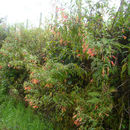Comprehensive Description
(
Inglês
)
fornecido por North American Flora
Lobelia laxiflora H.B.K. Nov. Gen. &Sp. 3: 311. 1819
Perennial, from a stout woody root; often in clumps; stem erect or ascending, shrubby, suflrutescent or sometimes herbaceous, usually more or less branched, green above and covered below with yellowish-brown bark, 20 cm. to 3 m. high (average height exceeding 1 m.), sometimes 1 cm. in diameter at base, glabrous, or densely short-pubescent above, terete, or somewhat angled below; cauline leaves mostly 10-30 (not including the leafy bracts), the lower often early deciduous; blades glabrous or pubescent, especially on the lower surface, thin and membranous or thicker and sometimes rugose, subcntire in outline or somewhat sinuate, mostly finely and regularly serrate, the serrations tipped with callose teeth; blades variable in size, usually from 0.9 cm. wide by 8.8 cm. long to 3 cm. wide by 9 cm. long and sometimes reaching I.S-25 cm. in length, in shape varying from linear-lanceolate to ovate or broad-elliptic, the tip acute or acuminate, the base cuneate or rarely rounded; lower leaves usually with a petiole 0.2-1 cm. long; inflorescence few-60 cm. long, generally not sccund, few-80-flowcrcd; pedicels stiffly upright or kxisely spreading, 10-100 mm. long in fruit, glabrous or sjiarsoly villoushirsutc, each with a pair of tiny inconspicuous bracteoles near the middle or below; flowerbract,s leafy, lanceolate to ovate, glabrous or pubescent, 21 5 cm. long, finely serrate, often so large that the flowers appear to be in the axils of the upi>cr foliage leaves rather than in a definite inflorescence; flower 27-48 mm. long, including hypanthium (averaging about 35 mm.); corolla red ("cerise," "coial-rcd," "orange-red," "pale-red," "scarlet") or the lobes yellow ("yellow," "orange-yellow," "orange"), or al! yellow, glabrous or short-pubescent without, the fuljc mostly 16-25 mm. long, fenestrate, the lower lip linear-oblong, 10-18 mm. long (usually slightly shorter than the tube), terminated by 3 acute teeth 1-3 (10) mm. long, not deflexed (sometimes slightly recun^ed), the two upper lobes of the corolla linear, acute, 10-20 mm. long by about I mm. wide; filament-tube 18-35 mm. long (averaging 22-25 mm.), slightly deflexed, pink, red, or "yellow, basally reddish," glabrous or strongly pubescent, the filaments connate about two-thirds their length; anther-tube 5-9 mm. long (averaging 6-7 mm.), yellowish, gray or "purpUsh," the two smaller anthers densely white-tufted at tip, the three larger villoushirsute, especially near the tip, or infrequently glabrous; h>-panthium in anthesis campanulate or shallowly cup-shaped, often wider than high, glabrous or pubescent, becoming broadly hemispheric in fruit, 6-9 mm. across by 4—7 mm. high; capsule more than half inferior, mostly 5-10 mm. long; calyx-lobes triangular, entire, acute, 1-6.5 mm. long (averaging about 3 mm.), glabrous or pubescent; seeds smoothish, ellipsoid or ovoid, with faint longitudinal lines, about 0.6 mm. long.
Type locality: Guerrero ("inter Quaxiniquilapa et Acaguisotla, alt. 500 hex.") (herb. Berlin, Field Mus. Neg. 9109!).
Leaves linear-lanceolate, averaging 10 times as long as wide; plants glabrous or essentially so, often purplish (highlands of the Mexican Plateau, from Oaxaca to Baja California and
Arizona). 7Sd. L. laxijhra var. angustifolia.
Leaves broader, usually 3-5 times as long as wide ; plants glabrous to tomentose, rarely if ever purplish. Flower-bracts conspicuously smaller than the foliage-leaves; leaves broad, mostly about 3 times as long as wide; inflorescence often compact , averaging not more than 20 cm .
in length (western Mexico, from Sonora to Chiapas). 7Sc. L. laxiflora var. Xelsonii.
Flower-bracts as large as the foliage leaves or nearly so, and essentially identical with them ; leaves averaging 5 times as long as wide but often wider than this; inflorescence various, often long. Pedicels flexuous, loosely spreading from the base; plants glabrous or sparsely pubescent (Guatemala and Honduras to Vera Cruz and Puebia). 786. L. laxiflora var. laxiflora. Pedicels stiff, closely and prominently appressed, at least at base; plants (rarely glabrous) slightly to densely pubescent (Michoac4n and Jalisco through Central America to Colombia). 78o. L. laxiflora var. slricta.
78a. Lobelia laxiflora var. stricta (Planch. & Oerst.) McVaugh, comb. nov.
Lobelia rigidula H.B.K. Nov. Gen. & Sp. 3:311. 1819. (Type probably from Mexico.)
Rapuntium ri^idulum Presl, Prodr. Mon. Lob. 26. 1836.
Lobelia ovalifolia H. & A. Dot. Beech. Voy. 300. 1838. (Beechey, Kew!)
Lobelia angulato-denlala H. & A. Bot. Beech. Voy. 301. 1838. (Beechey, Kew!)
Lobelia ftoribunda Bonpl.; A. DC. in DC. Prodr. 7: 383, as syn. 1839.
Lo6«Ha / andma Benth. PI. Hartw. 213. 1845. (Harlueg 1183. Kevi)
Siphocampylos mollis Regel, Flora 33: 353. 1850. (A garden plant, originally from Guatemala.)
Siphocampylos Warszewiczii Regel, Schweiz. Zeitschr. Gartenb. 8: 143. 1850. (Based on Siphocampylos mollis Regel, not 5. mollis Planch.)
Tupa costaricana Planch. & Oerst. Vidensk. Meddel. 1857: 154. 1857. {Oersted pi. cenlroam. 9245. Copenhagen!)
Tupa costaricana var. stricta Planch. & Oerst. Vidensk. Meddel. 1857: 155. 1857.
Tupa costaricana var. palula Planch. & Oerst. Vidensk. Meddel. 1857: 155. 1857.
Lobelia persicaefolia var. mollis Vatke, Linnaea 38: 722. 1874. (Herb. Berlin!)
Lobelia persicaefolia var. VVarscetviczii Vatke, Linnaea 38: 723. 1874. (Based on Siphocampylos Warszewiczii Regel.)
Ij)belia patzquarensis Sess* & Moc. PI. Nov. Hisp. 152. 1890. (Madrid!)
Lobelia laxiflora var. brevifolia Zahlbr. Repert. Sp. Nov. 14: 185. 1915. {Lehmann 4674.)
Lobelia laxiflora vai.foliosa Zahlbr. Repert. Sp. Nov. 14: 185. 1915. (Lehmann 3656, isotype, US!)
Lobelia laxiflora var. mollis Zahlbr. Repert. Sp. Nov. 14: 185. 1915.
Ixibelia costaricana F. E. Wimmer, Ann. Naturhist. Mus. Wien 46: 239. 1933.
/Lobelia costaricana var. magna F. E. Wimmer, Repert. Sp. Nov. 38: 85. 1935. (Hegewisch.)
lobelia Rensonii F. E. Wimmer, Repert. Sp. Nov. 38: 85. 1935. (Renson 54, NY!)
Leaves 1.5-3 (4.5) cm. wide, 4-10 (17) cm. long, usually 3-5 times as long as wide; plants usually pubescent, often densely so; pedicels stiff, straight, closely appressed to the stem at least at base.
Type locality: Not given; presumably in Costa Rica.
Distribution: Mountains, MichoacAn, Jalisco, and Nayarit; Guatemala to Colombia.
- citação bibliográfica
- Rogers McVaugh. 1943. CAMPANULALES; CAMPANULACEAE; LOBELIOIDEAE. North American flora. vol 32A(1). New York Botanical Garden, New York, NY

